5th ed. Brooks Cole Cengage Leaing. 2011. 966 p.
Providing even more emphasis on inquiry-based leaing, a new green experiment, and more than a dozen new discovery experiments, this Fifth Edition of Gilbert and Martin's proven EXPERIMENTAL ORGANIC CHEMISTRY contains procedures for both miniscale (also known as small scale) and microscale users. The manual first provides an early focus on equipment, record keeping, and safety in the laboratory, then walks students step by step through the laboratory techniques they need to perform the book's experiments with confidence. Chapters show students how to use the book's techniques to synthesize compounds and analyze their properties, complete multi-step syntheses of organic compounds, and solve structures of unknown compounds. A bioorganic experiment in Chapter 24 reflects the increasing emphasis on bioorganic chemistry in the course and gives students an opportunity to accomplish a mechanistically interesting and synthetically important coupling of two a-amino acids to produce a dipeptide.
Contents
Introduction, Record Keeping, and Laboratory Safety
Techniques and Apparatus
Solids: Recrystallization and Melting Points
Liquids: Distillation and Boiling Points
Extraction
Chromatography
Stereoisomers
Spectral Methods
Alkanes
Alkenes
Alkynes
Dienes: The Diels-Alder Reaction
Kinetic and Thermodynamic Control of a Reaction
Nucleophilic Aliphatic Substitution: Preparation of Alkyl Halides
Electrophilic Aromatic Substitution
Oxidation of Alcohols and Carbonyl Compounds
Reduction Reactions of Double Bonds: Alkenes, Carbonyl Compounds, and Imines
Reactions of Carbonyl Compounds
Organometallic Chemistry
Carboxylic Acids and Their Derivatives
Multistep Organic Synthesis
Polymers
Carbohydrates
alpha-Amino Acids and Peptides
Identifying Organic Compounds
The Literature of Organic Chemistry
Providing even more emphasis on inquiry-based leaing, a new green experiment, and more than a dozen new discovery experiments, this Fifth Edition of Gilbert and Martin's proven EXPERIMENTAL ORGANIC CHEMISTRY contains procedures for both miniscale (also known as small scale) and microscale users. The manual first provides an early focus on equipment, record keeping, and safety in the laboratory, then walks students step by step through the laboratory techniques they need to perform the book's experiments with confidence. Chapters show students how to use the book's techniques to synthesize compounds and analyze their properties, complete multi-step syntheses of organic compounds, and solve structures of unknown compounds. A bioorganic experiment in Chapter 24 reflects the increasing emphasis on bioorganic chemistry in the course and gives students an opportunity to accomplish a mechanistically interesting and synthetically important coupling of two a-amino acids to produce a dipeptide.
Contents
Introduction, Record Keeping, and Laboratory Safety
Techniques and Apparatus
Solids: Recrystallization and Melting Points
Liquids: Distillation and Boiling Points
Extraction
Chromatography
Stereoisomers
Spectral Methods
Alkanes
Alkenes
Alkynes
Dienes: The Diels-Alder Reaction
Kinetic and Thermodynamic Control of a Reaction
Nucleophilic Aliphatic Substitution: Preparation of Alkyl Halides
Electrophilic Aromatic Substitution
Oxidation of Alcohols and Carbonyl Compounds
Reduction Reactions of Double Bonds: Alkenes, Carbonyl Compounds, and Imines
Reactions of Carbonyl Compounds
Organometallic Chemistry
Carboxylic Acids and Their Derivatives
Multistep Organic Synthesis
Polymers
Carbohydrates
alpha-Amino Acids and Peptides
Identifying Organic Compounds
The Literature of Organic Chemistry

